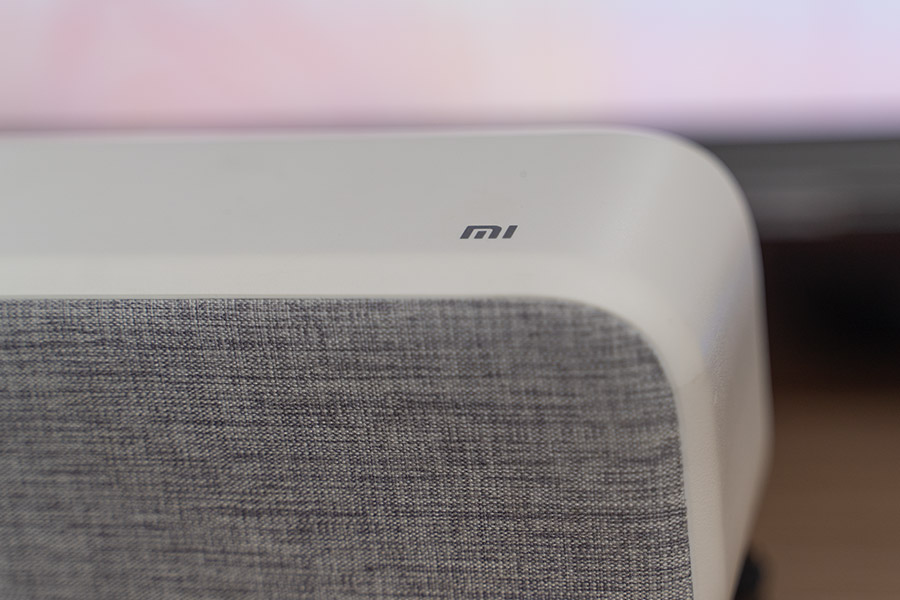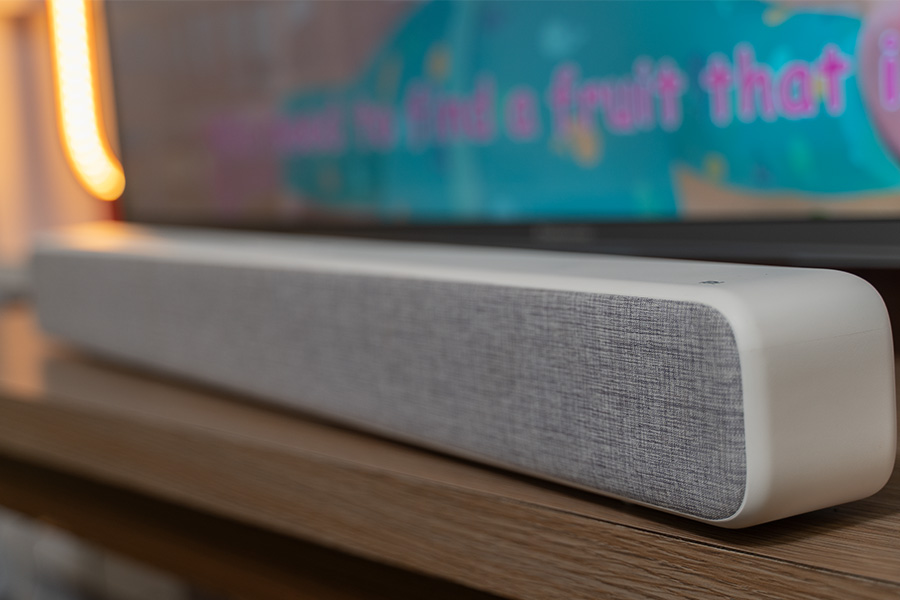
Over the years, even though TVs have continuously evolved in terms of picture quality, there hasn’t been that notable improvement when it comes to audio. You might have noticed the sound quality lacking the punch and missing the necessary depth in music, even in TVs that cost well over Rs. 1 lakh. But in this full review, I’ll be discussing if Xiaomi‘s Mi Soundbar can help solve that problem to any extent.
Mi Soundbar Specifications:
- Dimensions (H x W x D): 87 x 830 x 72mm
- Weight: 1.925 kg
- Speaker Units: 2x 20mm dome tweeters, 2x 2.5″ woofer, 4x 70x55mm passive radiators
- Frequency Response: 50Hz – 25kHz (-10dB)
- Normal Impedance: 6Ω (Ohms)
- Control: Buttons (Volume up/down, Toggle, Power on/off)
- Connectivity: 3.5mm stereo AUX-in, Fiber optic in, Coaxial in, R/W audio in
- Wireless: Bluetooth 4.2 (A2DP)
- Color Options: Black, White
- Price in Nepal: Rs. 8,999
- What’s inside the box: Soundbar, user manual, adapter, S/PDIF cable, 2x screws + 2x expansion screws
Mi Soundbar Review:
In all fairness, with the modern-day TVs getting slimmer in every iteration, it’s also getting harder for manufacturers to accommodate good and sizable audio drivers. And that has been one of the reasons for the compromises on the audio quality of TVs.

So despite investing a lot of money on a TV, we do not quite get the amazing viewing experience as the TV makers promise. To compensate for that tradeoff of the slim TVs, using a soundbar is a way to go.
And you can find different brands in the market with a lot of soundbar models in their lineup. Xiaomi recently launched the Mi Soundbar in Nepal, but it is actually a pretty old product that initially debuted in Q1 2019.
Design
- 87 x 830 x 72mm, 1.925 kg
- Cotton fabric mesh exterior
In terms of design, this soundbar doesn’t look particularly appealing. It comes in either white or black color options and is wrapped with a plastic casing at the back. On the other hand, its front is treated with cotton fabric mesh that ultimately delivers a somewhat sophisticated look. All in all, Mi Soundbar’s design is perfectly acceptable for its price.
Continuing with the design, you can find all the pairing and control buttons over on the top. Similarly, all of its ports are allocated on the back. The power on/off switch resides nearby on the same side as well.

Additionally, you’ll find two screw holes at the back. And it can come in handy if you are planning to mount the soundbar onto a wall. Thankfully, Xiaomi has also included two screws and two extension screws inside the box to help you wall-mount the Mi Soundbar.
Pairing and Control
- Bluetooth 4.2 wireless (A2DP)
- 3.5mm AUX-in, S/PDIF input
When it comes to connectivity, there are plenty of options. You can easily pair this soundbar with a television, laptop, or even a smartphone. Xiaomi has haughtily boasted that setting up Mi Soundbar won’t take more than 30 seconds. During our usage, we didn’t get to time the setup process but since it was pretty easy and quick, all’s well and good.

To connect the soundbar with a traditional CRT TV or a DVD player, you can give input to the soundbar through the Line In or the Optical port. Similarly, you can connect modern-day TVs making use of the S/PDIF port. And the good news is that you can find the S/PDIF cable inside the box itself.
Furthermore, there’s a 3.5mm audio jack to connect the Mi Soundbar with a smartphone, laptop, and any other device with a headphone connector. Besides wired connectivity, this soundbar features Bluetooth 4.2 for pairing with devices wirelessly as well.
Still, Bluetooth 4.2 doesn’t have as high bandwidth, data transfer speeds, or connectivity range as the newer Bluetooth 5.0/5.2 protocol, so there’s that. But before moving forward, there’s something important to understand.
You’ve got to select the proper input mode that matches the input port. For example, if you have connected your TV with the soundbar using the S/PDIF cable but have kept the input mode to Bluetooth, then it won’t work. So while setting up the connections, make sure you have done it right.

During the review period, what I didn’t like with the Mi Soundbar was the absence of a remote control. So, whenever you feel like changing the volume and such, you’ll have to do it so on the soundbar itself which is rather taxing. This is especially true when you have paired your audio input device via a S/PDIF cable.
Here, even changing the volume of the TV doesn’t have any effect on the volume levels of the soundbar. On the contrary, when connecting it wirelessly to a smartphone, laptop, or TV, Xiaomi lets you switch volume levels from the audio input device itself. So I hope Xiaomi will bring a dedicated remote controller in its next iteration of soundbars to save us from these kinds of hassles.
Audio Quality
- 2x 20mm dome tweeters
- 4x passive radiators
- 2x 2.5″ woofer drivers
- 50Hz – 25kHz frequency response
To deliver crisp and punchy audio, the Mi Soundbar has a promising audio driver setup. The audio module comprises 8 sound drivers in total. Among them, two are woofers dedicated to delivering audio of a wide frequency range.
Similarly, there are four passive radiators to take care of the bass (low-frequency spectrum). Lastly, there are two tweeters that complete the audio driver setup. Here, the tweeters handle trebles or the high-frequency soundwaves of audio.

With such a capable audio setup inside, we were expecting an awe-inspiring sound quality. For this review, we connected the Mi Soundbar to our office TV and watched a couple of shows, and listened to some music. And what we found was that its loudness is plenty sufficient for watching the TV programs in a small group of people.
However, when streaming content among a large group of friends and in a more spacious room, it was not the same. Therefore, I wished it were a bit louder. Anyway, I’m quite fond of the bass from this soundbar. You can really feel the oomphs, all thanks to the four passive radiators.
If Xiaomi had managed to include a sub-woofer as well, it would’ve been even better. Maybe this design decision was to keep the prices low and that’s completely understandable. However, treble and mids do not sound as polished. By that, I don’t mean the music or the dialogues of movies aren’t heard properly.
But you won’t find it as smooth as the way bass sounds. And that’s even more pronounced when playing treble-heavy songs at high volume. On a related note, I don’t particularly recommend you play music from the Mi Soundbar at high volume since the audio starts getting distorted at those settings.

And when going for the wireless route, sadly, there’s no support for a high bit-rate audio codec like aptX on this soundbar. Instead, it caves in to the basic A2DP Bluetooth profile that simply can’t deliver high-quality, uncompressed audio like aptX, for instance. As a result, if high-quality audio is what you want, then you’re gonna have to go down the wired route.
Mi Soundbar Review: Verdict
From the budget point of view, the Mi Soundbar is a decent performer and delivers louder audio than most of the slim TVs out there. It also delivers better depth in audio quality than most budget TVs in 2021. But when comparing it with high-quality soundbars and bigger sound-boxes, the Mi Soundbar is a no-match.

So if you are looking for a budget-friendly way to elevate your TV viewing experience in terms of audio, the Mi Soundbar is undeniably a great option. But if you are not ready for any sorts of compromises, you should definitely get a Surround Sound System or a good Home Theatre System.
- Watch our video review of the Mi Soundbar (Nepali).
Mi Soundbar Review: Pros & Cons
Pros:
- Decent design language
- Extension screws inside the box
- Adequate port selection
- Can get fairly loud enough
- Impressive bass reproduction
Cons:
- Older Bluetooth 4.2 connection
- No high bit-rate audio output
- Doesn’t feature remote control
- Mids, highs don’t sound as nice
- Noticeable distortion at high volume








![Best Gaming Laptops in Nepal Under Rs. 250,000 (रु 2.5 Lakhs) [2025] Best Gaming Laptops Under 2.5 lakhs in Nepal [Feb 2025 Update]](https://cdn.gadgetbytenepal.com/wp-content/uploads/2025/02/Best-Gaming-Laptops-Under-2.5-lakhs-in-Nepal-Feb-2025-Update.jpg)
![Best Gaming Laptops in Nepal Under Rs. 120,000 (रु 1.2 Lakhs) [2025] Best Budget Gaming Laptops Under Rs 120000 in Nepal 2025 Update](https://cdn.gadgetbytenepal.com/wp-content/uploads/2025/05/Best-Budget-Gaming-Laptops-Under-Rs-120000-in-Nepal-2024-Update.jpg)
![Best Laptops Under Rs. 80,000 in Nepal [2025] Best Laptops Under 80,000 in Nepal March 2025 Update](https://cdn.gadgetbytenepal.com/wp-content/uploads/2025/03/Best-Laptops-Under-80000-in-Nepal-March-2025-Update.jpg)
![Best Laptops Under Rs. 70,000 in Nepal [2025] Best Laptops Under 70,000 in Nepal March 2025 Update](https://cdn.gadgetbytenepal.com/wp-content/uploads/2025/01/Best-Laptops-Under-70000-in-Nepal-March-2025-Update.jpg)
![Best Mobile Phones Under Rs. 15,000 in Nepal [Updated 2025] Best Phones Under 15000 in Nepal 2024 Budget Smartphones Cheap Affordable](https://cdn.gadgetbytenepal.com/wp-content/uploads/2024/03/Best-Phones-Under-15000-in-Nepal-2024.jpg)
![Best Mobile Phones Under Rs. 20,000 in Nepal [Updated] Best Mobile Phones Under NPR 20000 in Nepal 2023 Updated Samsung Xiaomi Redmi POCO Realme Narzo Benco](https://cdn.gadgetbytenepal.com/wp-content/uploads/2024/01/Best-Phones-Under-20000-in-Nepal-2024.jpg)
![Best Mobile Phones Under Rs. 30,000 in Nepal [Updated 2025] Best Phones Under 30000 in Nepal](https://cdn.gadgetbytenepal.com/wp-content/uploads/2025/01/Best-Phones-Under-30000-in-Nepal.jpg)
![Best Mobile Phones Under Rs. 40,000 in Nepal [Updated 2025] Best Phones Under 40000 in Nepal 2024 Smartphones Mobile Midrange](https://cdn.gadgetbytenepal.com/wp-content/uploads/2024/02/Best-Phones-Under-40000-in-Nepal-2024.jpg)
![Best Mobile Phones Under Rs. 50,000 in Nepal [Updated 2025] Best Phones Under 50000 in Nepal](https://cdn.gadgetbytenepal.com/wp-content/uploads/2025/01/Best-Phones-Under-50000-in-Nepal.jpg)
![Best Flagship Smartphones To Buy In Nepal [Updated] Best flagship phone 2025](https://cdn.gadgetbytenepal.com/wp-content/uploads/2024/07/Best-Flagship-Phones-who-is-it-ft-1.jpg)